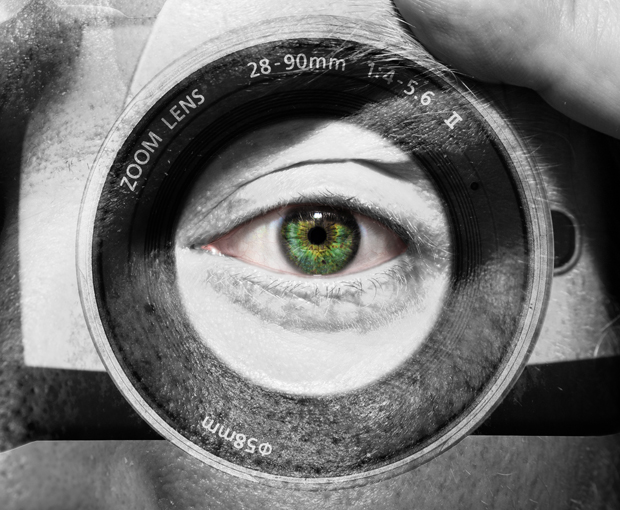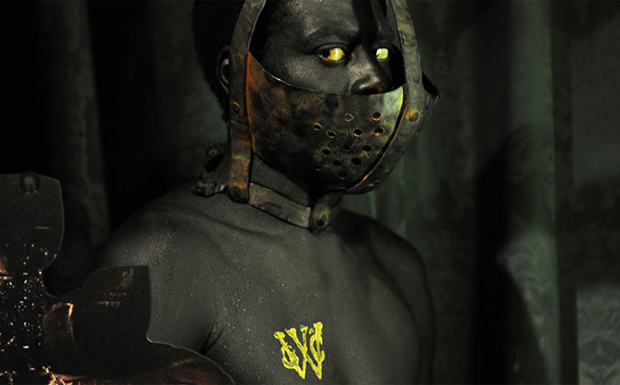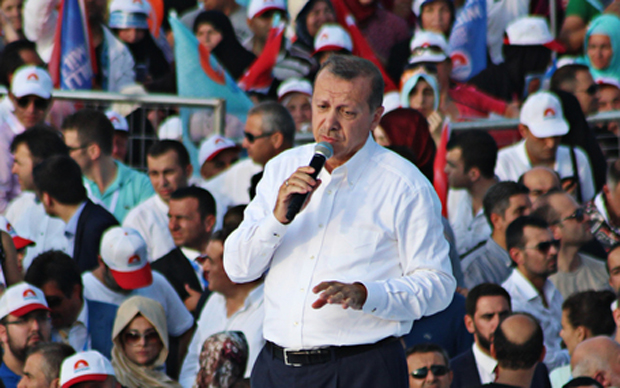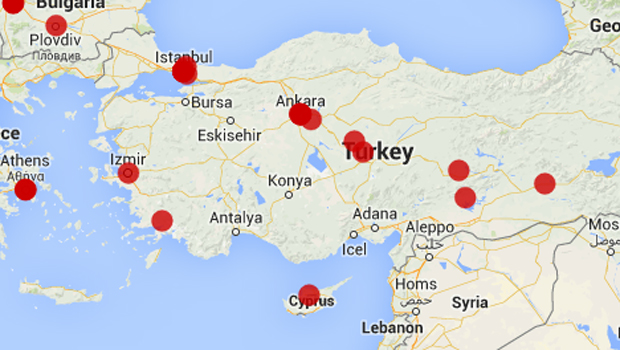25 Sep 2014 | News and features, Religion and Culture, United States

(Photo: Shutterstock)
For us jaded Europeans, the United States’ first amendment, with its simple pledge that the government will keep out of the business of religion and censorship, seems as stubbornly, oafishly American as Hulk Hogan. It’s a loud tourist with a bumbag, wasting his money in an Angus Steakhouse; it’s Burt Reynolds’ moustache; it’s Jane Russell’s specially-constructed brassiere; it’s brash and unsubtle and does not do nuance.
Which is why we’re so ready to accept the idea that a US court has decided that the first amendment concept of free speech trumps all, even sexual harassment. Especially if that court is in Texas, the bit, we imagine, that makes the rest of the United States look sophisticated.
“Texas court upholds right to take ‘upskirt’ pictures”, said the Guardian, while the Independent tweeted “You’re legally allowed to take upskirt pictures in Texas because it’s ‘freedom of expression’” (note the scare quotes).
The stories under the headlines concerned a ruling by the Texas Court of Criminal Appeals in a case concerning a man named Ronald Thompson.
Thompson had been caught taking pictures of children and women at a water park in San Antonio, focusing on what I believe is called the “bikini area”. Thompson reportedly tried to delete the photos as he was apprehended. He was indicted on 26 counts under Texas’ “improper photography or visual recording” law.
Thompson appealed the indictments on the grounds that the law was incompatible with the first amendment. The court agreed with him, leading to the headlines across the world. Most reports, including, it should be said, the American ones, went hard on the “upskirt” or “creepshot” angle, declaring it was now entirely legal to well, be a creep with a camera in Texas.
Is it really? Well, sort of, ish.
The judgement issued by the court is a genuinely fascinating read for anyone interested in free expression, far from the gun-toting, sexual harassment-ignoring, good ole boy decision it has been represented as. It involves discussion about what constitutes the public realm and the nature of consent. It goes into some detail as to whether the act of photography is in itself creative expression, and decides it is.
Some commentators, such as Salon’s Jenny Kutner have picked up on the wording in the judgment suggesting that “Protecting someone who appears in public from being the object of sexual thoughts seems to be the sort of ‘paternalistic interest in regulating the defendant’s mind’” as evidence of a court being more interested in a pervert’s right to perv than a woman’s right not to be harassed.
But it’s actually a point well worth making. Courts and governments cannot be involved in what people find sexually arousing in their imaginations; it’s only if actions cause harm to others that the law should intervene.
This is not, then, a ruling taken lightly. Rather it reviews very seriously a badly written law.
The law itself, section 21.15 of the Texas Penal Code, reads as follows:
(b) A person commits an offense if the person:
(1) photographs or by videotape or other electronic means records, broadcasts, or transmits a visual image of another at a location that is not a bathroom or private dressing room:
(A) without the other person’s consent; and
(B) with intent to arouse or gratify the sexual desire of any person;
The “bathroom or private dressing room” exclusion seems weird, but is only there because the next clause specifically refers to bathrooms and private dressing rooms, presumably drafted in light of some kind of Chuck Berry scenario (the guitar legend was accused of secretly taping people using bathrooms in his Missouri restaurant).
The problem is that this is far too broadly drawn as a law, but also weirdly specific. What it does not address at all is what might be a reasonable expectation of privacy in public: it is not a serious argument to suggest that one must always actively give consent to being photographed in public space. But it is reasonable to expect that no one should be taking upskirt pictures of you: the judgment acknowledges as much, specifically mentioning upskirt photographs as an “intolerable” breach of privacy.
The weird specificity comes with the “sexual desire” bit; why is this kind of thought worse than any other? Shouldn’t the focus be on the breach (or not) of privacy, rather than what thoughts the images might lead to? Apart from the argument over whether photography is an act of expression, it is this clause that raises free expression problem with the law: put simply, the human mind is capable of eroticising pretty much anything. Any kind of picture could “arouse or gratify the sexual desire of any person”. Once again, the focus is in fact taken away from the act of breaching privacy and towards the act of expression.
In spite of initial appearances, the Texans have done a good thing here. The state will now have to come up with a law that properly balances privacy and free expression, rather than giving just piecemeal thought to either concept.
First amendment cases often solicit astonished responses. But more often than not, a first amendment consideration isn’t just free expression rolling into town in its monstrous, burger chewing, gasoline drinking, Okie from Muskogee way. No. More often than not, the first amendment forces some real thought and analysis to take place in public life.
This article was posted on Thursday, September 25, 2014 at indexoncensorship.org
25 Sep 2014 | Azerbaijan, Azerbaijan News, News and features

Rasul Jafarov, Arif Yunus and Leyla Yunus (Photos: Rasul Jafarov (© IRFS), Arif and Leyla Yunus (© HRHN))
Disregarding the motion by European Parliament earlier this week, Azerbaijan has failed to release political prisoners Leyla and Arif Yunus, Rasul Jafarov, Intigam Aliyev and Hasan Huseynli.
Leyla and her husband have now been imprisoned for 56 days, since July 30. On September 22, Leyla’s lawyers questioned her current condition after not being allowed into her cell and being denied an opportunity to speak with her on the phone. Guards told the lawyers she was sick and refused to speak with them. In a joint statement the lawyers expressed that the circumstances Leyla is being exposed to in the prison, including being subjected to acts of violence, “raise a lot of concerns”.
Jafarov, now detained for 53 days, since August 2, wrote an appeal earlier this week in which he asserted that he was falsely accused of hiding evidence and not cooperating in the investigation, and that his imprisonment is a result of a government order. “I present my arguments regarding the baselessness of the attribution of each ground to me and the fact that there was a ‘political order,’”he wrote.
Intigam Aliyev has been imprisoned for 47 days, since August 8. Hasan Huseynli, who has been detained for 178 days, since March 30, was recently sentenced to six years in Azerbaijani prison.
These five and 93 other political prisoners held in Azerbaijan were the subject of last week’s Platform London protest outside of BP’s headquarters on September 17. The protest called for BP to end its funding of the authoritarian regime on the anniversary of “the Contract of the Century”. A letter was also given BP, requesting they call on the Aliyev regime to release the 98 political prisoners and that they end their sponsorship of the 2015 Baku European Olympic Games. BP verbally agreed to meet with Platform, but has yet to formally respond to the letter.
This article was posted on 25 September 2014 at indexoncensorship.org
24 Sep 2014 | News and features, Religion and Culture, United Kingdom

Exhibit B will take place at the Barbican Sept 23-27, 2014. (Photo: © Sofie Knijff / Barbican)
Update: Exhibit B was cancelled by the Barbican, the Evening Standard reported, after protesters blockaded the entrance and branded it ‘racist’.
If artistic culture is to be truly dynamic, strong, representative and relevant, the programmes in our theatres, galleries and museums will necessarily be challenging. The work, presented by many different voices, will likely be divisive; and causing offence, whether unintended or deliberate, is unavoidable.
The role of the arts institution in this dynamic cultural life is to manage the space between the artist and the audience, to create a place in which different ideas about the world we live in can be expressed, challenged, exalted, ridiculed and celebrated.
Brett Bailey’s Exhibit B, programmed for four days at the Barbican beginning tomorrow, has certainly caused considerable offence; 22,500 people have signed a petition calling for the Barbican to withdraw this exhibition, declaring their intention to protest outside the venue during the run.
The work by the South African theatre maker was inspired by human zoos, popular in 18th and 19th centuries, where human beings of African heritage were put in cages on display alongside animals for the titillation of European audiences. It recreates 12 tableaux of atrocities featuring live actors, who the audience is asked to observe in silence. Brett Bailey’s idea behind Exhibit B is to immerse the visitor in visions of horror and inhumanity to “provoke audiences to reflect on the historical roots of today’s prejudices and policies”.
What interests me here is the role and mindset of the institution presenting this piece of work and whether it considered, if at all, the possibility of a hostile response. I requested an interview with the Barbican, but was told they would speak after the show, once I had seen the exhibition.
For Exhibit B to be anything other than another here-today-gone-tomorrow exhibition that takes the messages of the work to heart, the Barbican would have to be engaged in dialogue with black artists and audiences as part of an ongoing commitment to eradicate institutional racism from the arts. Yet it is the boycott organised against this exhibition, with its petition, speeches, protests, marches, public meetings, pickets, on and offline debate that is ensuring that any dialogue is happening, albeit in reaction to the programming of Exhibit B, and from the outside.
In response to the boycott, Barbican commissioned Nitro to organise a public debate: Discussions, Learning and Legacy at Theatre Royal Stratford East Monday 22nd.
The panel for the passionate and heated debate about Exhibit B, excellently chaired by Olu Alake, featured six speakers – three supporting the boycott, including Sara Myers author of the Petition and three supporting the work including Louise Jeffries from the Barbican who programmed the work. After each speaker had had their say, the audience of around 150 people, unleashed a barrage of questions from the floor. The two hours allotted to the debate were woefully inadequate for the range and depth of opinion expressed. As anticipated the debate changed nothing in the short term, the work will open this evening as planned, but there was an urgent call for a longer, fuller discussion which hopefully Barbican will respond to as a matter of urgency.
By giving a major international platform to Exhibit B without significant contemporary context, engagement or dialogue, the Barbican is unwittingly shining a light on both its own failure and the failure of the wider arts and culture scene to challenge prejudice and policy in the arts in the United Kingdom. Surely it cannot be possible for the Barbican to stand by a work that purports to confront “colonial atrocities committed in Africa, European notions of racial supremacy and the plight of immigrants today” and not see that it is holding up a mirror to itself.
Mark Sealy, artistic director at Autograph Black Photographers, who I spoke to last week about the boycott, was unequivocal: “Since 1980s it is progress zero. Our institutions have failed to bring about change – whether it is academia, the McPhearson Report or funding policies – [black] people feel absented from power, authoring and having a voice” And the reason? “There are no consequences to this failure. These policies have not made an iota of difference. If they want their institutions to be truly diverse they would withdraw the money from institutions if they don’t deliver.”
Independent arts consultant Jenny Williams takes a pragmatic view by heading up the campaign JustCulture, featuring a 10-point manifesto for change, though she knows, also from years of experience, without investment and commitment from the establishment there is little hope that things will change. She has crunched the numbers: “The Arts Council funding of arts infrastructure is not fairly representing the 14% black and minority communities. 14% of ACE’s overall three-year investment of £2.4bn would equate to £336m – that’s £112m per year. The black and minority ethnic community contribute around £62m per year into the overall arts budget. Yet, the current yearly figure currently invested in black and minority ethnic-led work is £4.8m.”
In spite of this grossly unbalanced situation, the organisers of the boycott I have spoken to are talking about how they can turn this into a positive. As Sara Myers, author of the boycott told me, she sees the mass outpouring of frustration and outrage as a catalyst. “A door has opened and we want to take the opportunity to challenge stereotypes, rather than sit back and see them reinforced.” She was however shocked when she met the board and senior management of the Barbican – with one exception, all white.
In her five-star review of Exhibit B for The Guardian, Lyn Gardner says the show “reminds us that most history is hidden from view”. I would say history here is on display for all to see. I defend Brett Bailey’s right to present these horrendous atrocities from the past – anything else is censorship – and agree with Lemn Sissay that we should all be free to revisit this story “in every part of every generation”.
But the more potent issue here, is the perpetuation of institutionalised mono-cultural bias preventing the Barbican, and the vast majority of British arts institutions, from fostering and delivering a truly relevant cultural programme. This untenable form of censorship must be addressed and continue to be addressed long after Exhibit B has been and gone.
This article was posted on 22 September 2014 at indexoncensorship.org
24 Sep 2014 | Digital Freedom, Mapping Media Freedom, News and features, Turkey

Former Turkish Prime Minister and current president Recep Tayyip Erdogan spoke to tens of thousands of supporters during a presidential campaign rally in Istanbul in early August. (Avni Kantan / Demotix)
Seven months after a previous amendment was introduced to Turkey’s contentious 5651 law governing internet activity, new restrictions were passed late on September 8. Before the February amendments were signed into law by then President Abdullah Gül, a protracted approval process over the course of a few weeks helped bring attention to the proposals. In contrast to the online and street protests against internet censorship that preceded the amendments’ approval earlier this year, last week’s changes to the 5651 law were rushed through a vote before word could spread about them.
The newest restrictions are only two articles tucked into a lengthy omnibus reform bill: in a total of seven sentences, amendments number 126 and 127—part of a list of 146—succinctly make way for invasive data logging and the speedier blocking of access to websites. Nihan Güneli, an Istanbul-based technology and media lawyer, said the hurried vote on the bill kept opposition to the internet regulations muffled. When the details of the earlier 5651 amendments were first presented in January, Güneli said, “everybody was protesting it. I believe that was one of the main reasons Abdullah Gül rejected these two main articles. But this time we didn’t have any time. We just saw the article and everybody was shocked.”
Before approving the last amendments in February, Gül urged legislators to adjust two of its articles: one measure allowing for Turkey’s Telecommunications Directorate (TİB) to block access to some websites within four hours – without a court order, was changed to require judicial review. Another measure that gave TİB the right to collect internet users’ data was changed to restrict access to user logs.
Former Prime Minister Erdogan replaced Gül as Turkey’s new president on August 28. Less than two weeks after his inauguration, these newest internet restrictions allow for websites to be blocked within four hours if their content is ruled a threat to national security or public order, or if restricting access to them can prevent a crime. Under the new amendment, TİB is also allowed to store internet users’ traffic logs and metadata. In an attempt to make the February bill amendable to critics, these two most offensive parts of the previous amendments to 5651 were dropped at Gül’s request. Now exactly those measures have been quietly put into effect under Turkey’s new president.
The targeting of websites determined to be threats to national security comes after the Turkish government struggled to suppress a series of leaked phone recordings earlier this year that spread on social media. The wiretapped phone conversations featured what appeared to be the voices of Prime Minister Erdogan and people close to him, and pointed to their implication in an ongoing corruption scandal. Other recordings ostensibly showed Erdogan’s meddling in the judiciary and with owners of major media outlets. In March, a leaked recording from a meeting at Turkey’s foreign ministry detailed the government’s considerations for military involvement in Syria. Shortly after that recording was posted on YouTube, access to the platform was blocked entirely in Turkey.
YouTube is one prominent example of access restrictions prior to the most recent legislation reform—the website was previously banned for over two years up until 2010. The possible effects of the newest amendments’ measures for blocking websites are still unclear, although the implications for access to information are startling. A number of small, alternative news websites have been aggressively covering the Turkish government’s recent corruption scandal. With no offline distribution form, their livelihood would be put at risk if their websites became inaccessible.
The news website Diken was founded in January 2014 and has since gained a following for its alternative reporting. In June, Diken was named “internet newspaper of the year” by an environmental organisation. Editor in chief Erdal Güven says Diken published almost every one of the leaked government phone recordings earlier this year. So far, Diken has not been shut down or admonished by authorities, which Güven suggests may be because the website is still less than one year old and may not be considered a sufficient threat. Diken risks being targeted by TİB at any point, though, says Güven. “It depends on an advisor to a minister, an MP, the president. Just to read a story of ours and then complain to the legal authorities,” Güven said. Referring to the fines media companies can face for publishing information deemed illegal, Güven added, “They can ask us to pay a huge amount of money. We don’t know what they will do. We don’t have a huge amount of money, we have a tight budget. Of course this would affect us.”
Because of their editorial choices and coverage of government scandals, alternative news sources and social media are the main targets of the new restrictions on website access. Elif Örnek, a reporter for the leftist newspaper soL, says that journalists are often pressured or face censorship, and in reporting on issues that the government is trying to suppress, like the leaked phone recordings, the stakes can be especially high for the media. “The main thing is that when you’re thinking about the public interest, there are some dangers you have to risk,” Örnek said.
For internet users, TİB’s broad collection of metadata is a newly legal tool for monitoring online activity. Nihan Güneli says it’s impossible to predict how TİB will purpose users’ traffic logs. “Within six months, maybe we’ll hear about a case, maybe somebody will be arrested or someone committed a crime and we’ll see this traffic information in court. Then we’ll know what they’re doing with it,” Güneli said. Censorship of websites within Turkey is not new, making it hard to predict whether the new bill’s other article, which gives TİB the authority to block sites within four hours, will have palpable effects on access to information. “TİB has power right now and nobody knows what they’re going to do with it. I don’t think they know either,” Güneli said.
Media violation reports from Turkey via mediafreedom.ushahidi.com

Twitter account of Today’s Zaman editor faces closure
Habertürk fires reporter
Journalist kidnapped and released by PKK
Report shows media use of hate speech increased in early 2014
Several media organisations denied accreditation to AK Party congress
This article was posted on 24 Sept 2014 at indexoncensorship.org





